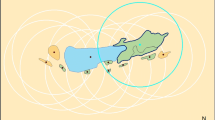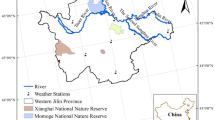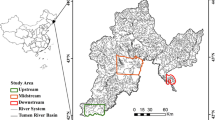Abstract
In 2007, the Taiwanese government used the criteria of species richness, degree of wilderness/representativeness/uniqueness, and appropriateness/reasonability to identify 74 wetlands as being of importance. They were ranked according to the order of importance and classified into three levels: wetlands of international, national, and local importance. We examined the landscape status of these wetlands, each including a 100-m-wide swath of surrounding land area and the wetland itself, and calculated landscape development intensity (LDI) index values, as used in earlier assessments in Florida, USA. The LDI index values were ranked and classified into three levels as done by the Taiwanese government. We compared the ranking of the LDI index values with those evaluated by the Taiwanese government and found that there was 67.6% congruency, suggesting that the LDI index can be used to assess the biodiversity status of wetlands. Our results also suggested that the LDI index can be used to assess coastal wetlands. This provides rapid and timely information on landscape development which can prove useful for managing wetlands in Taiwan. However, there was some variability between the two rankings, apparently resulting from the incongruence of some land-use categories used in Florida and Taiwan. It is recommended that Taiwan develop LDI coefficients corresponding to land-use categories based on its own natural and anthropogenic landscapes.


Similar content being viewed by others
References
Barbier EB, Acreman M, Knowler D (1997) Economic valuation of wetlands, a guide for policy makers and planners. Ramsar Convention Bureau, Gland
Brown MT, Vivas MB (2005) Landscape development intensity index. Environmental Monitoring and Assessment 101:289–309
Costanza R, d’Arge R, de Groot R, Farber S, Farber M, Hannon B, Limburg K, Naeem S, O’Neill RV, Paruelo J, Raskin RG, Raskin P, Van den Belt M (1997) The value of the world’s ecosystem services and natural capital. Nature 387:253–260
Findlay SC, Houlahan J (1997) Anthropogenic correlates of species richness in southeastern Ontario wetlands. Conservation Biology 11:1000–1009
Lane CR, Brown MT (2007) Diatoms as indicators of isolated herbaceous wetland condition in Florida, USA. Ecological Indicators 7:521–540
Houlahan JE, Findlay CS (2003) The effects of adjacent land-use on wetland amphibian species richness and community composition. Canadian Journal of Fisheries and Aquatic Sciences 60:1078–1094
Mack JJ (2006) Landscape as a predictor of wetland condition an evaluation of the landscape development index (LDI) with a large reference wetland dataset from Ohio. Environmental Monitoring and Assessment 120:221–241
Mack JJ (2007) Developing a wetland IBI with statewide application after multiple testing iterations. Ecological Indicators 7:864–881
Mack JJ, Avdis NH, Braig EC IV, Johnson DL (2008) Application of a vegetation-based index of biotic integrity for Lake Erie coastal marshes in Ohio. Aquatic Ecosystem Health and Management 11:91–104
Nestlerode JA, Engle VD, Bourgeois P, Heitmuller PT, Macauley JM, Allen YC (2009) An integrated approach to assess broad-scale condition of coastal wetlands—the Gulf of Mexico Coastal Wetlands pilot survey. Environmental Monitoring and Assessment 150:21–29
Odum HT (1996) Environmental accounting: emergy and environmental decision making. Wiley, New York
O’Neill RV, Hunsaker CT, Jones KB, Riitters KH, Wickham JD, Schwartz PM, Goodman IA, Jackson BL, Baillargeon WS (1997) Monitoring environmental quality at the landscape scale. Bioscience 47:513–519
Ramsar Convention Secretariat (2006) The Ramsar convention manual: a guide to the convention on wetlands (Ramsar, Iran, 1971), 4th edn. Ramsar Convention Secretariat, Gland
Reiss KC, Brown MT (2007) Evaluation of Florida palustrine wetlands: application of USEPA levels 1, 2, and 3 assessment methods. EcoHealth 4:206–218
Ueng YT (2007) Taiwan wetlands of importance. Construction and Planning Agency, Ministry of the Interior. Taipei, Taiwan
USEPA (2006) Application of elements of a state water monitoring and assessment program for wetlands. Wetlands Division, Office of Wetlands, Oceans, and Watersheds, U.S. Environmental Protection Agency, Washington, DC http://www.epa.gov/owow/wetlands/
Acknowledgments
We thank Mr. Chen-Kuang Lee, Mr. Peng-Sheng Chen and Miss Yun-Chien Chou of the Urban and Rural Development Branch, Construction and Planning Agency, Ministry of the Interior, who provided help and advice on the important wetlands layer and data. We express our appreciation to Miss Ying-Ting Huang of the National Land Surveying and Mapping Center, Ministry of Interior, who provided help and advice on the Land Use Investigation of Taiwan layers and data, and to Mr. Jian-Xin Wu and Miss Ya-Qi Zhan of the Endemic Species Research Institute for assistance on the data analysis. We are most indebted to Dr. Chu-fa Tsai for providing constructive comments and suggestions, and extend our appreciation for the comments from two anonymous reviewers who helped clarify and strengthen the article.
Author information
Authors and Affiliations
Corresponding author
Appendix 1: Three classes of land-use categories in Taiwan, with each of the categories in class 3 assigned landscape development intensity (LDI) coefficients based on the Florida land-use classification system (Brown and Vivas 2005). * These land-use categories were not associated with the wetland
Appendix 1: Three classes of land-use categories in Taiwan, with each of the categories in class 3 assigned landscape development intensity (LDI) coefficients based on the Florida land-use classification system (Brown and Vivas 2005). * These land-use categories were not associated with the wetland
Class 1 | Class 2 | Class 3 | LDI coefficients |
1. Agriculture | 1. Farmland | 1. Rice paddy | 2.77 |
2. Dry farmland | 4.54 | ||
3. Orchard | 3.68 | ||
4. Uncultivated farmland | 2.77 | ||
2. Aquaculture | 5. Aquaculture | 1.83 | |
3. Livestock | 6. Poultry farm | 7.00 | |
7. Pasture | 3.74 | ||
4. Agriculture facility | 8. Greenhouse | 8.07 | |
9. Storage facility | 8.07 | ||
10. Produce market | 8.07 | ||
11. Other facilities | 8.07 | ||
2. Forestry | 5. Natural forest | 12. Conifer forest | 1.00 |
13. Broadleaf forest | 1.00 | ||
14. Bamboo forest | 1.00 | ||
15. Bamboo-broadleaf forest | 1.00 | ||
6. Artificial forest | 16. Conifer plantation | 1.58 | |
17. Broadleaf plantation | 1.58 | ||
18. Bamboo plantation | 1.58 | ||
19. Bamboo-broadleaf plantation | 1.58 | ||
7. Other forest land | 20. Clear cut forest land | 1.58 | |
21. Tree nursery | 1.58 | ||
22. Fire lane | 1.58 | ||
23. Timber Landing facility | 1.58* | ||
3. Transportation | 8. Airport | 24. Airport | 8.28 |
9. Railroad | 25. Regular railroad | 7.81 | |
26. High-speed railroad | 7.81 | ||
27. Railroad facility | 7.81 | ||
10. Road | 28. Path | 8.28 | |
29. National highways | 8.28 | ||
30. County and local roads | 7.81 | ||
31. Road facility | 8.28 | ||
11. Harbor | 32. Commercial harbor | 8.28* | |
33. Fishing harbor | 8.28 | ||
34. Harbor for special use | 8.28 | ||
35. Harbor facility | 8.28 | ||
4. Water conservancy | 12. River | 36. Natural river | 1.00 |
37. Dredging river | 1.83* | ||
38. Water canal | 7.81* | ||
39. Embankment | 7.81 | ||
13. Drainage ditch | 40. Drainage ditch | 1.83 | |
14. Reservoir | 41. Reservoir | 1.83 | |
42. Natural lake | 1.83 | ||
43. Water storage ponds | 1.83 | ||
44. Artificial lake | 1.83 | ||
15. Sand bar | 45. Sand bar | 1.00 | |
16. Water work facility | 46. Water gate | 8.07 | |
47. Pumping station | 8.07 | ||
48. Dam | 8.07 | ||
49. Underground well | 8.07 | ||
50. Other facilities | 8.07 | ||
17. Dike | 51. Dike | 7.81 | |
18. Sea | 52. Sea | 1.00 | |
5. Community | 19. Business | 53. Service industry | 9.18 |
54. Retail and wholesale stores | 8.00 | ||
20. Housing | 55. Residential house | 6.79 | |
56. House for residence and manufacture | 8.66 | ||
57. House for residence and business | 8.66 | ||
58. House for residence and other uses | 8.66 | ||
21. Industry | 59. Manufacturing industry | 8.32 | |
60. Storage facility | 8.32 | ||
22. Building for other uses | 61. Church and temple | 8.07 | |
62. Funeral home and cemetery | 8.07 | ||
63. Building in construction | 8.07 | ||
64. Others | 8.07 | ||
6. Public land | 23. Governmental building | 65. Governmental building | 8.07 |
24. School | 66. Kindergarten | 8.07 | |
67. Elementary school | 8.07 | ||
68. Middle school | 8.07 | ||
69. Colleges and university | 8.07 | ||
70. Special school | 8.07* | ||
25. Medical health care facility | 71. Hospital and health care facility | 8.07 | |
26. Social welfare agency | 72. Social welfare facility | 8.07 | |
27. Public utility facility | 73. Meteorological station | 8.07 | |
74. Electric power facility | 8.07 | ||
75. Gas facility | 8.07 | ||
76. Public water facility | 8.07 | ||
77. Gasoline station | 8.07 | ||
28. Environmental protection facility | 78. Environmental protection facility | 8.07 | |
7. Recreation and leisure | 29. Cultural facility | 79. Decretory cultural facility | 6.92 |
80. General cultural facility | 6.92 | ||
81. Other facilities | 6.92 | ||
30. Leisure facility | 82. Park (green yard) | 1.83 | |
83. Amusement place | 6.92 | ||
84. Play ground | 6.92 | ||
8. Mining and graveling | 31. Mining industry | 85. Mining ground | 8.32* |
86. Mining facility | 8.32* | ||
32. Gravel industry | 87. Gravel pits | 1.83 | |
88. Gravel related facility | 6.92 | ||
33. Salt industry | 89. Salt pan | 1.83 | |
90. Salt related facility | 6.92* | ||
9. Miscellaneous | 34. Military base | 91. Military base and facility | 8.07 |
35. Wetland | 92. Wetland | 1.00 | |
36. Glass land | 93. Glass land | 1.00 | |
37. Bare land | 94. Beach | 1.00 | |
95. Land slide area | 1.00 | ||
96. Rocky crag | 1.00 | ||
97. Exposed open ground | 1.00 | ||
38. Bush land | 98. Bush land | 1.00 | |
39. Natural disaster area | 99. Natural disaster area | 1.83 | |
40. Left over land from construction | 100. Left over land from construction | 1.83 | |
41. Vacant land | 101. Unutilized building land | 1.83 | |
102. Land in construction | 1.83 | ||
103. Surveyor’ beacon | 8.07* |
Rights and permissions
About this article
Cite this article
Chen, TS., Lin, HJ. Application of a Landscape Development Intensity Index for Assessing Wetlands in Taiwan. Wetlands 31, 745–756 (2011). https://doi.org/10.1007/s13157-011-0191-6
Received:
Accepted:
Published:
Issue Date:
DOI: https://doi.org/10.1007/s13157-011-0191-6




